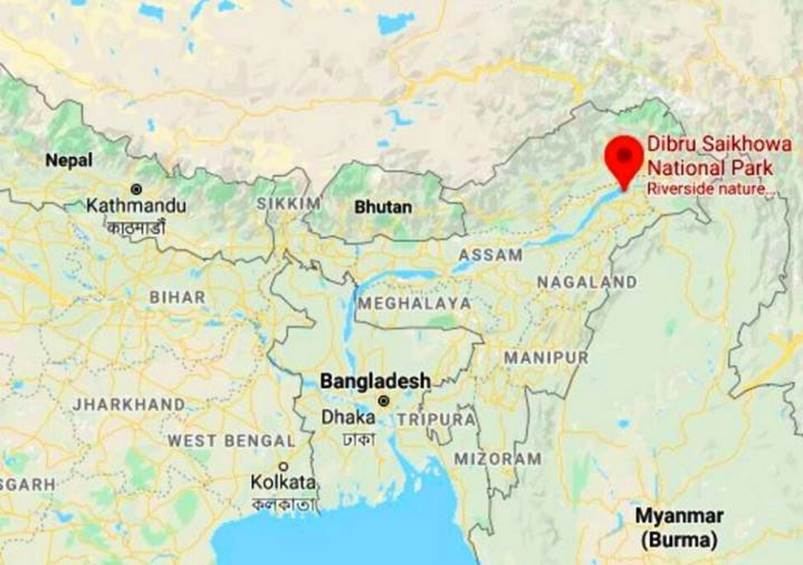Basics – Location and Background
- Location: Assam, North-East India, situated in Tinsukia and Dibrugarh districts.
- Geography:
- Lies between Brahmaputra and Lohit rivers.
- Characterized by floodplain ecosystem, wetlands, grasslands, and forest patches.
- Status:
- Declared a National Park in 1999 (earlier a Wildlife Sanctuary since 1986).
- Also recognized as a Biosphere Reserve (1997) due to its rich biodiversity.
- Size: Around 765 sq km (core + buffer).
Relevance : GS 3(Environment and Ecology)

Ecological Features
- Grassland Ecosystem:
- DSNP has large patches of alluvial grasslands, which are dynamic and seasonally changing due to floods.
- Supports unique species adapted to disturbance (floods, erosion, silt deposition).
- Forest and Wetlands: Mix of semi-evergreen forests, moist deciduous forests, bamboo, and “beels” (oxbow lakes).
- Riverscape Dynamics: Brahmaputra’s changing course constantly reshapes landforms, creating habitat flux.
Biodiversity Significance
- Flora: Tall grasses (Saccharum, Phragmites, Arundo), swamp vegetation, aquatic plants.
- Fauna:
- Mammals: Feral horses (unique attraction), tiger, leopard, elephants, Asiatic water buffalo, Gangetic river dolphin.
- Birds: Over 300 species; critically endangered species like White-winged Wood Duck, Bengal Florican.
- Aquatic: Rich ichthyofauna due to riverine network.
- Conservation Value: Grasslands of DSNP are critical for endangered birds and large herbivores.
Grasslands in Flux – Core Issue
- Dynamic Grasslands:
- Annual floods deposit new silt and erode old patches.
- Grassland cover fluctuates, making it unstable for species needing permanent grassland.
- Successional Change:
- Without regular flooding/fire, grasslands naturally succeed into woodland.
- This reduces open habitats for grassland specialists like Bengal Florican.
- Anthropogenic Impact:
- Encroachment, grazing, and fuelwood collection accelerating grassland degradation.
- Oil exploration and industrial activity in Assam’s upper Brahmaputra valley threaten ecosystem stability.
Human and Livelihood Context
- Local Communities: Depend on park’s grasslands and wetlands for grazing, fishing, fuelwood, reeds.
- Conflicts: Displacement due to floods + restrictions from conservation → pressure on resources.
- Tourism Potential: River island safaris, bird-watching, feral horses. But unregulated tourism can disturb fragile grasslands.
Conservation Challenges
- Hydrological Alterations: Embankments, dams upstream affect natural flood cycles essential for grassland regeneration.
- Encroachment & Agriculture: Grassland converted into croplands in fringe areas.
- Invasive Species: Mimosa and water hyacinth spread in wetlands, choking native vegetation.
- Oil & Gas Exploration: Repeated conflicts between conservation and industrial interests in DSNP region.
- Climate Change: Erratic flood patterns + river course shifts increasing ecosystem instability.
Ecological Importance of Grasslands in DSNP
- Carbon Sink: Tall grasses act as carbon sequestration zones.
- Flood Mitigation: Absorb excess water, reduce erosion.
- Biodiversity Hotspot: Grassland-specialist species depend on its survival.
- Cultural & Livelihood Value: Traditional dependence of locals on reeds, thatch, grazing.
Policy and Legal Framework
- Protected under Wildlife Protection Act, 1972.
- Biosphere Reserve status provides additional management framework.
- Subject to national policies on wetlands, grassland conservation, and disaster risk management (flood-prone ecosystem).
- Supreme Court and NGT have intervened in cases against oil drilling inside DSNP.
Way Forward – Management Strategies
- Adaptive Grassland Management: Controlled burning, flood simulation, and removal of invasive species.
- Community Participation: Eco-development committees for grazing regulation, eco-tourism benefit-sharing.
- Hydrological Restoration: Maintaining flood cycles by reducing embankment pressures.
- Biodiversity Monitoring: Long-term mapping of grassland area shifts and species population dynamics.
- Integrated Landscape Approach: Link DSNP with larger Brahmaputra floodplain conservation strategy.



